Summary :
MacConkey Agar : Principle, Preparation and Interpretation
MacConkey Agar holds a prominent position in microbiology laboratories and is considered one of the most extensively utilized agar media. In this article, we explore its principle, preparation and interpretation for the selective cultivation and differentiation of Gram-negative bacteria
◉ Overview
MacConkey Agar is a solid, selective and differential medium, specifically designed to promote the growth of gram-negative bacteria. Moreover, it enables the further distinction of Gram-negative organisms by assessing their ability to metabolize lactose :
- Lactose fermenters, colonies, turn red or pink on MacConkey agar
- Non-fermenters do not change color.
Growth rate, lactose fermentation rate, and presence or absence of a capsule are also ways to further differentiate organisms in the Macconkey agar.
The macconkey medium is developed by Alfred Theodore MacConkey in 1900.
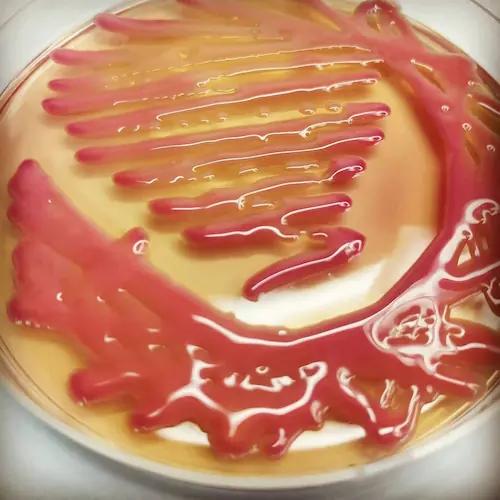
Macconkey agar
◉ Preparation / Composition of Macconkey agar
Suspend the components, dehydrated powder, in water (49.53 grams in 1000 ml of purified / distilled water). The medium is boiled for a few seconds until the ingredients are completely dissolved. Sterilize by autoclaving at 15 lbs (121 ° C) pressure for 15 minutes.
Cool to 47 ° C, mix well before pouring into sterile Petri dishes.
MacConkey Agar Composition |
|||
|---|---|---|---|
| Ingredients | Gram / liter | Ingredients | Gram / liter |
| Peptone (Pancreatic Digestion of Gelatin) | 17g | Neutral red | 30 mg |
| Proteose peptone (meat and casein) | 3g | Crystal violet | 1 mg |
| Lactose monohydrate | 10g | Agar | 13.5 g |
| Bile salts | 1.5g | Distilled water | 1 litre |
| Sodium chloride | 5 g | Final pH | 7.1 +/- 0.2 |
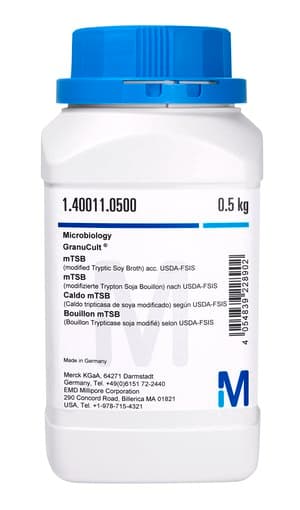
MacConkey Agar Dehydrated
◈ The lactose in the medium can be replaced by other sugars : MacConkey with sorbitol.
◈ A variant of MacConkey agar without crystal violet and salt can be used to limit the swarming of Proteus spp.
◉ Principle and interpretation of MacConkey agar
◈ MacConkey Agar is a selective and differential medium used for the isolation and differentiation of non-fastidious Gram-negative bacilli, in particular members of the Enterobacteriaceae family and the genus Pseudomonas.
◉ Selectivity of MacConkey agar
Crystal violet dye and bile salts stop the growth of gram-positive bacteria. This only allows gram-negative species, which have a relatively bile-resistant outer membrane, to form colonies on MacConkey agar.
◉ Differentiation of MacConkey agar
Gram-negative bacteria that grow on MacConkey plate are differentiated by their ability to ferment lactose.
- Bacteria which ferment lactose decrease the pH of the medium, this decrease is detected by neutral red(become red if pH below 6.8). When the pH drops, the neutral red is absorbed by bacteria, which appear as bright pink to red colonies on the agar : Escherichia coli, Enterobacteria, Klebsiella
- Gram negative bacteria that thrive on MacConkey agar but do not ferment lactose appear colorless on the medium and the agar surrounding the bacteria remains relatively transparent : Salmonella, Proteus, Yersinia, Pseudomonas
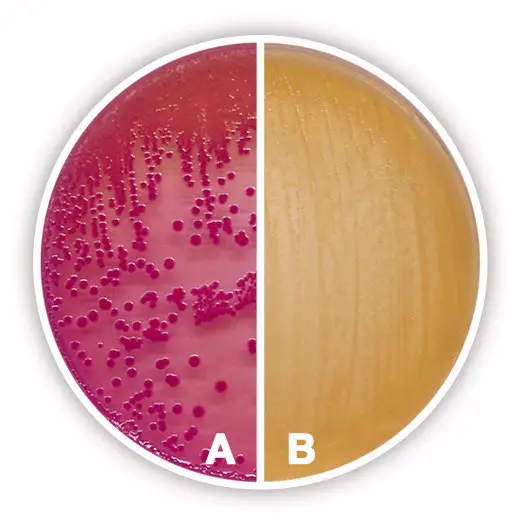
MacConkey agar plate : lactose fermentation (A) vs non-fermentation of lactose (B)
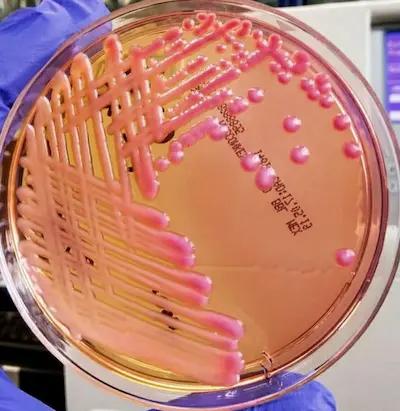
MacConkey agar plate : Klebsiella colonies are often mucoid, large (4-6 mm) and dark to pale pink (@lab.elm)
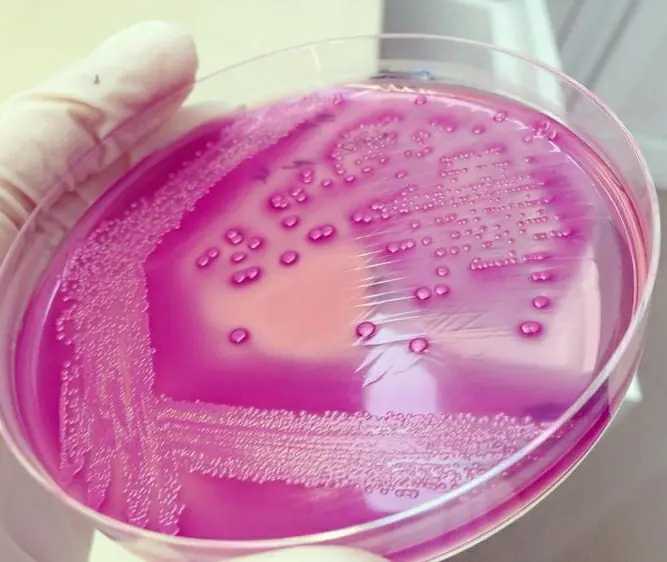
Colonies of Escherichia coli on MacConkey agar palte are pink to dark pink, dry and donut-shaped, surrounded by a dark pink area of precipitated bile salts.
Note:
⚡ Gram-positive bacteria will not form any colony on MacConkey medium (with a few exceptions).
⚡ Bacteria with strong lactose fermentation produce enough acid to precipitate bile salts, resulting in a pink halo in the medium surrounding individual colonies or areas of confluent growth.
⚡ Weak lactose fermenters will form colonies more slowly than others. Example: Serratia, Citrobacter
⚡ Slow lactose fermenters may appear as colorless colonies. Example : Enterobacter (More details)
⚡ The encapsulated bacteria produce capsules by using lactose. This results in sticky, moist-looking colonies. Example : Klebsiella, Enterobacter
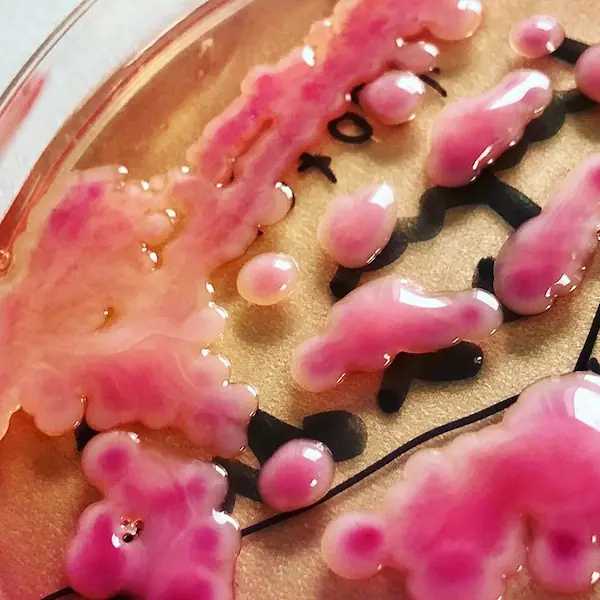
Mucous strain of Klebsiella on MacConkey agar(@microbiology-cluj)
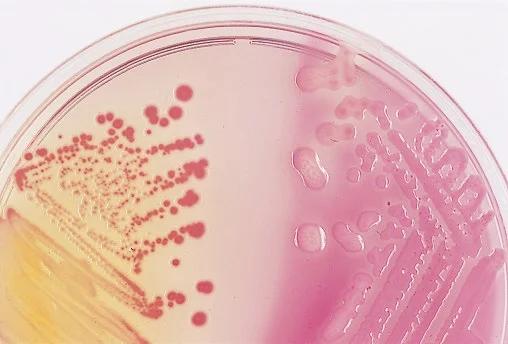
Enterobacter spp., On the left, are often late lactose fermenters, and so colonies may appear colorless to light pink.(1)
◉ Variants of Macconkey agar
◉ 1- MacConkey with Sorbitol (Sorbitol-containing MacConkey agar (SMAC))
- This medium uses D-sorbitol rather than lactose to isolate and differentiate enteropathogenic serotypes of E. coli that tend to be sorbitol negative.
- E. coli O157: H7 (EHEC) is sorbitol negative and the colonies appear colorless, while other strains of E. coli ferment sorbitol and appear as pink colonies with 100% sensitivity and 85% specificity.
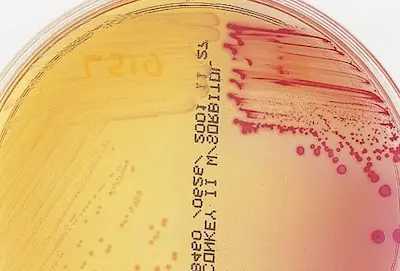
MacConkey with sorbitol : on the left an E. coli O157: H7 sorbitol negative (source: Color Atlas of Medical Bacteriology 4ed)
◉ 2- MacConkey without crystal violet and salt
Sodium chloride is removed from the medium to provide an electrolyte deficient medium preventing Proteus spp from spreading. In addition, this medium does not contain crystal violet allowing the growth of Staphylococcus, Enterococcus and Mycobacterium spp.
◉ Frequently asked questions
Q : Why is MacConkey agar used for urine culture?
A : Macconkey agar makes it possible to select and differentiate directly from a urine sample the gram-negative rods, which includes most of the bacteria responsible for urinary tract infections
Q : Does Salmonella grow on MacConkey?
A : Yes, salmonella can grow on MacConkey, salmonella doesn't utilize lactose (Colorless colonies ).
Q : How does E. coli appear on MacConkey agar?
A : E coli will,by fermenting lactose, lower the pH and change the color to pink to dark pink
Q : Does Shigella grow on MacConkey?
A : Yes, Shigella can grow on MacConkey, Shigella doesn't utilize lactose (Colorless colonies ).
Q : Is MacConkey selective or differential?
A : MacConkey agar is selective and differential
Q : What make MacConkey agar selective??
A : Crystal violet dye and bile salts halt the growth of gram-positive bacteria.